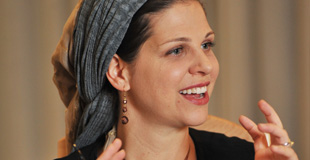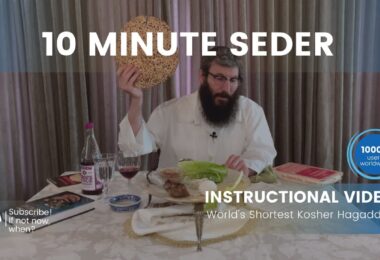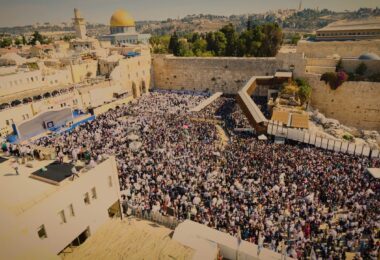This is another in a series that I am writing about Nachlaot.
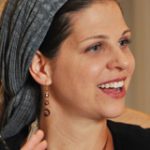

Chaya Lester
She came to Israel for the first time when she was seventeen years old. It was as a participant on the March of the Living program which includes a tour of Poland and the Auschwitz concentration camp.
When she was eighteen she returned to Israel and studied at both Neve Yerushalayim and Machon Pardes. The two schools could not be farther apart philosophically. Neve Yerushalayim is a Haredi women’s school. Machon Pardes is an open college where anyone can study and has mixed classes for men and women. It has a reputation for being more liberal on religious issues such as women’s equality in the synagogue.
Chaya went to the University of Pennsylvania and graduated in 1997. She first made aliyah in 1998, then returned to the U.S. to study for an M.A. in psychology at the University of California Berkley. Chaya also studied Jewish history in London.
In 2006 she married her husband Hillel and they went to live in the Bat Ayin settlement in Gush Etziyon. She and her husband went there because her husband studied to be a rabbi at the yeshiva there.
Chaya and Hillel opened the Shalev Center in 2011. The name Shalev comes from the Hebrew word “Shilva” which means tranquility or peacefulness. Chaya blends her training in psychology with Tora and Kabbala. “Anything we can turn into a deep piece of wisdom,” she said.
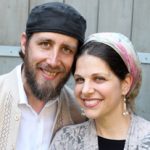

Hillel and Chaya Lester
They offer individual and couples counseling. There are one on one as well as group sessions. They have 10 couples doing a 6 week process. Hillel gives meditation classes. Chaya and Hillel want to use Tora and traditional forms of therapy to help people gain a better understanding of their lives.. Their programs are not, however, limited to the religious community.
The Shalev Center is located in a beautifully renovated house in Nachlaot. It is conveniently across an alley from the Hassidic/Carlebach Yeshivat Simchat Shlomo. Their style fits in with that of Simchat Shlomo and its student base as well as the Nuevo-Chassidic community in Nachlaot. “It just fell into our laps,” said Chaya of the location. She feels that getting the building was like a gift from God.
The ground floor is used for seminars and shows. The second floor holds their offices. The third floor of the house has their counseling rooms and the family resides on the top floor. Chaya and Hillel have three young children, six year old twins (a boy and a girl) and a three year old daughter.
Chaya has her own one woman show called “Babel’s Daughter” which she has been performing for three years. Babel refers to the fact that she grew up in “exile”. Chaya started the show by performing it in the center. She studied drama in college. Chaya felt that comedy was a good tool for therapy, “Jewish women making Jewish jokes,” she says.
“The show gets people to engage in our work in a light setting,” explains Chaya. “It helps people to think about their connection to Israel, Judaism and their selves.”
It begins with an explanation of Chaya’s Southern American roots. First she teaches the audience how to say Bible Belt – a term referring to the deep south because of its predominantly Christian nature –with a proper southern accent.
When she was a kid after Hebrew school she and friends would commit acts of mischief, such as stealing lipstick from local stores. Now when she returns to Memphis her non-Jewish friends from school are surprised to see that she has become religious. They always thought of her as a rebel who would never conform to something like religion. But as Chaya explains, “my rebel nature is what led me to become Orthodox.”


Chaya in performance
Chaya continues with her story through the time when she lived with her husband at Bat Ayin. They were there when two terrorist attacks occurred: in one a man was murdered while walking outside of the confines of the settlement and the other was when an axe wielding terrorist murdered a teenage boy. Chaya was deeply troubled by these attacks and so she and her family returned temporarily to Tennessee.
Babel’s Daughter is interactive. Each member of the audience is given a small notebook made to look like a passport. Throughout the performance, Chaya asks reflective questions and the attendees write their feelings down. She uses a mock passport in her shows since it’s a symbol of going on a journey. Chaya says that her show is, “not entertainment but inner-tainment.”
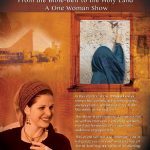

Babel’s Daughter
Hechal Shlomo is located in downtown Jerusalem on King George Street next to the Great Synagogue. It houses a synagogue, a restaurant, a number of offices and classrooms as well as a permanent display of items from various synagogues. It recently held a performance of Babel’s Daughter as part of an art festival including a temporary art exhibit of paintings by 30 different artists. The festival began after Yom Kipur and will continue until Hanukah.
Some of the displays were just plain silly, such as one where someone poked a bunch of holes in the wall and simply called it “holes in the wall.” One display was nothing more than a blown up photograph of something shot close up.
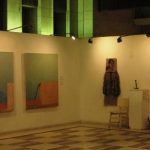

Part of the Hechal Shlomo Exhibit
Some were interesting. Morya Levi, 26, is a married religious woman who just completed her studies in arts at Emunah College in Talpiyot. Her contribution to the exhibit is a series of photographic self portraits based on famous paintings.


Morya’s Display
Interestingly, for a religious woman, Morya chose to put herself on display. She also chose a painting of Mary and the baby Jesus as the basis for one of her self portraits, Morya says that she was not making a statement of any kind. She just liked the original painting. “I’m looking for my connection to the paintings as a mother,” said Morya.
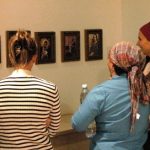

Women looking at Morya’s Photographs
Noa Cohen, 37, is the assistant curator of Hechal Shlomo’s museum. She lives in Nachlaot, has five children and is currently working on a PhD in art at Bar Ilan University. Noa also contributed to the temporary exhibit. Her work is titled “Yichudim,” which is Hebrew for “oneness”.


Noa Cohen next to her display
Noa’s works are based on Kabalistic ideas. This is where the word Yichudim comes from. Noa says that if you look closely at her paintings you can see kabalistic terms hidden within them.
- On Turning 50 and Other Observations - 8/7/2020
- Pesach Movies To Watch While You Social Distance - 4/12/2020
- You vote for Likud – Not BIBI - 9/16/2019

